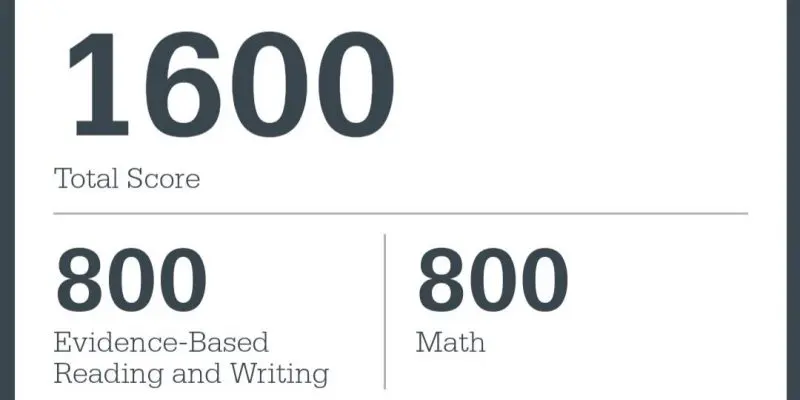
Familiarizing yourself with the different SAT sections can even make or break your SAT scores, especially if you want that perfect score. So, it’s important to know that the SAT is divided into 4 major SAT Sections and 1 optional portion.
What Are the SAT Sections?
According to the non-profit organization that created the SAT, it consists of four distinct sections.
- The reading section tests skills such as understanding words in context and your ability to find evidence in support of your claims.
- Writing and Language will help test your expression of ideas, control of the English language, and your command of evidence.
- Math without calculator has tests on problem solving, data analysis, algebra and other math topics.
- A math section where students are allowed a calculator
- Lastly is the essay, which is optional to test reading comprehension and writing skill.
The SAT is supposed to help you test everything you learned in high school and everything you’ll need to survive college. With the SAT, you’ll be sure to be well-equipped with the right skills you’ll need as a college student. There are a variety of ways to prepare the for SAT but it’s always good to know what you’re heading into. So how many questions are in the SAT you might ask?
Every section in the SAT has a fixed number of questions and a time limit to finish.
The entire SAT has 154 questions, which you are allowed to answer for 180 minutes.
The SAT Essay is separate and involves only one essay, which you are allowed to write for an additional 50 minutes.
You’ll find the breakdown of the SAT sections to be as follows:
- Reading has 52 questions and 65 minutes to finish.
- Writing and Language has 44 questions but only 35 minutes to finish.
- Math without the calculator has 20 questions and 25 minutes to finish.
- Math using the calculator has 38 questions and a 55 minute time limit.
Except for the essay section and Math with calculator subsection, all other sections follow a multiple-choice SAT format. If you find a unique question, it could possibly be an experimental or pre-test question that doesn’t factor into your score. College Board has these questions because they want to see if these questions are fair and appropriate for future versions of the SAT. When this happens, you will get another 20 minutes since you will find more questions in the exam.
The SAT Reading Section
The SAT Reading Section is subdivided into five types of passages. The first type is a fiction passage that has 10 questions. This usually comes from a story in US or world literature. Another two are science-based passages that are taken from science journals and other scientific documents. The last two remaining ones will come from history and social studies. Though this is a breakdown this might not be the exact order you’ll see on your SAT.
The Reading section tests your ability to comprehend the context of passages, determine the tone of a text, and find evidence within a particular passage to support your answer to the questions given. Since the entire reading section runs 65 minutes with a total of 52 questions, you only have around 1 minute and 15 seconds to answer each question so you will need to take SAT reading practice seriously to ensure that you’ll be able to complete it on time. Additionally, reading passages are not exclusive to texts. Sometimes, there will be charts, graphs and other types of data.
For some people, this is the easiest SAT section, but since we aren’t equal, other students may still find the questions hard. If this is the case, the best advice is to skip that particular passage, continue with the Reading section and come back to the unanswered questions. The goal here is to ensure that you complete the most amount of questions within the time limit.
The SAT Writing and Language Section
You might be confused to see the writing and language section separate from the reading section. “Are they not the same?” I can hear you saying and you’re not entirely wrong. This section also revolves around how well you’ll understand the passages, so if Reading tests your comprehension, writing tests your editing skills.
The writing and language section consists of four passages. Each passage has 11 questions. You must answer the entire section within 35 minutes. With that, you’ll only have about a minute and ten seconds to complete the section.
Unlike the Reading passages that are fiction and focus only on specific topics, passages on the Writing Section are all nonfiction with topics ranging from science to humanities, careers, social studies, history, and so much more. You’ll be faced with arguments or narratives, which you will deem either right or wrong. It will be wise to practice your SAT grammar rules in preparation for this section.
The SAT Math Section
The Math Section has two subsections: a calculator and non-calculator section.
In the calculator portion, you are allowed to use a calculator to solve any of the 38 questions and you have only 55 minutes to complete it. Though this sounds great, you’ll still need to practice to ensure you don’t trip on any of the common mishaps from using your calculator such as recognizing whether your calculator is using radians or degrees. Lastly you can’t use any calculator, they have to be approved by college board. You can find a list here.
In the no calculator portion, you cannot use your calculator. There are 20 questions and you are given 25 minutes to complete this section. Even though this sounds like a daunting task, most of the questions will not need any complicated mathematical formulas and division usually doesn’t go any further than a couple of decimal points.
Both subsections will test your problem solving and real-world math skills.
In addition, around a quarter of the math section has a grid-in question format. Instead of choosing from the provided multiple choice answers like the rest of the SAT sections, grid-in questions require you to solve the problem and enter the answer in the provided grids of your answer sheet. Make sure you understand how this is done, since entering numbers in the wrong location could lead to a wrong answer immediately.
The SAT Essay (Optional)
The SAT essay is an optional section, since not all colleges and universities require this for college applications. Plus, the College Board only attaches one essay per student, so taking multiple essays wouldn’t really be ideal unless you feel your first essay was just average.
If you’re going to take the essay, you’ll have 50 minutes to work on it.
In the beginning you must read the 600-800 word passage. Be sure to fully understand the passage before continuing. The next step should be to make an outline. Your essay shouldn’t be whether or not you agree with the passage but to analyze how well the author does in advocating their position.
After your finishing your outline and gathering supportive evidence, you should start writing. Be sure not to rush but make sure you finish your outline and reading fast enough to leave enough time for the writing. Additionally, leave a couple of minutes to proofreading your essay. It’ll help you catch any mistakes you might have made earlier and make your essay just that much stronger.
Your essay will be graded according to your reading comprehension, analysis, and writing skill. Two people will be grading your essay based on these 3 components and giving them a score on a scale of 1 to 4. Scores from both grades will then be added to look something like 2|2|2 (the lowest essay score) to 8|8|8 (the highest score possible).
Are Certain SAT Sections More Important Than Others?
When it comes to scoring, the SAT has two major test sections: Math and the Evidence-Based Reading and Writing Test. Each section will receive a score ranging from 200 to 800. When you add scores to these sections, you get the composite score that ranges between 400 and 1600. This number is a big deal because it is prominently displayed at the top of your SAT score report and colleges usually look at the score to gauge a student’s college readiness or as a major factor for initial screening.
However, there are some instances where universities and colleges look at section scores. It is for this reason as well that students could focus better on certain SAT sections than others. These instances include:
- If you do well on the section that matches type of learning you will do for your major. For example, if you do exceptionally well on your math section, you might have a leg up in math heavy majors. However they might dock you if you were aiming for a more literary major and did poorly on the reading and writing sections.
- If the college is looking for a tie-breaker. Maybe you and another student are fighting for the last spot and the admissions committee is looking for something extraordinary that could pop out from your section scores.
Key Takeaways for the SAT Sections
All high school students planning to go to college will eventually take the SAT. If you’re among the thousands of students who are heading to these testing centers soon, you know how important this endeavor is for your career.
Most students work hard studying for the SAT, but many also overlook the step of learning all about SAT sections. We hope by reading this guide, you have now learned that:
- Every SAT section tests the student’s different academic skills
- Colleges use your total SAT score (or composite score) for initial screening, so aim high.
- You must focus on your weaknesses when studying. If you’re behind math, double-up on your Math SAT preps.
Make sure to check the official College Board website, especially if you’re scheduled to take the SAT soon. They regularly update guidelines for this standardized test, which is why you could find guides comparing the old SAT vs new SAT. Always go with the most updated guidelines. If not, you might be following an outdated rule and waste all your hard work.










